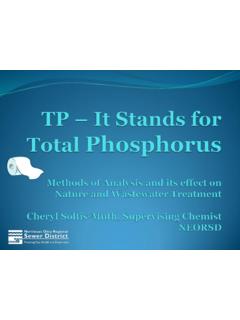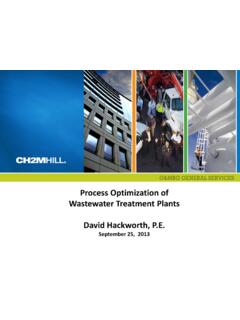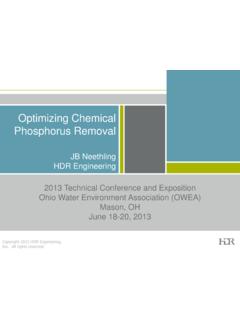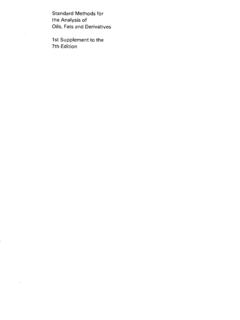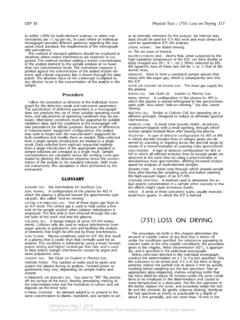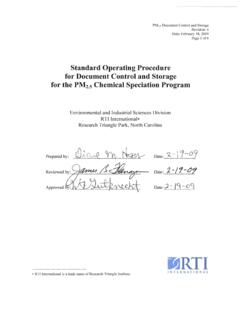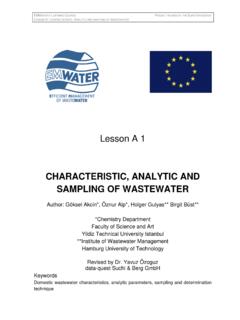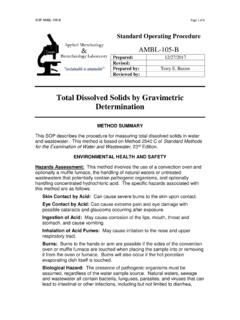Transcription of Determination of Readily Biodegradable COD ( rbCOD)
1 Determination of Readily Biodegradable COD ( rbCOD) Presented by: Radek Bolek Wastewater Biodegradable and non- Biodegradable fractions Influence of Readily Biodegradable COD ( rbcod ) and other COD fractions on wastewater treatment Determination of rbCODby: Chemical-physical analysis (estimation) Respirometry Conclusions2 COD FractionsWastewater Biodegradable and non- Biodegradable fractionsCharacterization of wastewater with regard to the organic content is useful from the standpoint of modeling, process control and prediction of effluent quality. Analytical parameters such as Biochemical Oxygen Demand (BOD) and Chemical Oxygen Demand (COD) are routinely used to reflect the total organics in wastewater. COD is estimated to be a more useful parameter than BOD, but from a modeling standpoint, COD cannot differentiate between Biodegradable and inert organic matter or between Readily and slowly Biodegradable Biodegradable and non- Biodegradable fractions5 Wastewater Biodegradable and non- Biodegradable fractionsTypical raw and settled portionsof wastewater COD fractions in total CODB iodegradable COD (bCOD)Raw: : COD (nbCOD)Raw: : (SS) to to (XS) to to (SI) to to (XI) to to Biodegradable and non- Biodegradable fractions7 Why Biodegradable COD rather thanBOD?
2 BOD only measures the organics used for respiration and ignores what is converted to biomassBOD ignores the non- Biodegradable carbonaceous matterWhere:YH- Heterotrophic yield coefficient (mg cell COD / mg COD removed)8 Biodegradable COD (bCOD) Biodegradable (bCOD)Consists of the total fraction from COD that can be biodegraded by the heterotrophic microorganisms. Readily Biodegradable ( rbcod , SS)Consists of small molecules that are directly available for biodegradation by heterotrophic microorganisms ( volatile fatty acids, alcohols, amino-acids, simple sugars) Slowly Biodegradable (sbCOD, XS)Consists of larger molecules requiring extracellular breakdown (hydrolysis) before being biodegraded by the heterotrophic microorganisms (proteins, FOG, complex carbohydrates)9 Non- Biodegradable COD (nbCOD) Soluble non- Biodegradable COD (nbsCOD)Soluble fraction is not affected by contact with the biomass, does not undergo any changes during treatment and is discharged with the effluent.
3 Particulate non- Biodegradable COD (nbpCOD)Particulate fraction forms significant portion of primary and/or waste activated sludge. nbCODimpacts significantly the plant sludge production and of Readily Biodegradable COD ( rbcod ) HighrbCOD(>30%) witha highF/McanleadtheprocesstowardsBulking&F oamingInfluence of Readily Biodegradable COD ( rbcod ) F/M: Food/Microorganisms ratio SRT: Sludge Retention Time (d)F/M ( rbcod ): F/M only related to rbCODW hentheaerationtankisoperatingunderlimite doxygenation,a rbCODwithhighCODuptakerateUcancausea dramaticfallofthedissolvedoxygenleveltoz eroppm,creatinganunwantedanoxiczone,whic hcouldleadtheprocesstowardsa of Readily Biodegradable COD ( rbcod ) Simultaneous DO and U Respirogramsin respirometer in R test mode for rbCODdetermination 13 High rbCODwith a limited hydraulic retention time can develop a partial nitrification and risk of nitrite in the of Readily Biodegradable COD ( rbcod ) 14 Enhanced Biological Phosphorus Removal (EBPR)
4 A two-step process of phosphorus release and uptake under alternating anaerobic and aerobic or anoxic conditions where Phosphate Accumulating Organisms or PAOs use rbCODto accumulate phosphorous (normal cells have 1-2% P where PAOs can have up to 40%) rbCODconcentration (especially concentration of VFA) in anaerobic zone is a critical factor for successful biological phosphorous of Readily Biodegradable COD ( rbcod ) 15 The rbcod , in the influent of the anoxic zone, is the carbonaceous material available for the heterotrophic biomass to develop the denitrification process. For this reason, a lack of rbCODwill lead the process to a poor denitrification of Readily Biodegradable COD ( rbcod ) Solublecarbonaceous matter / Nitrate = [ rbcod (1 YH) ]/ [ N_NO3d ] = or higherN_NO3d (mg/l): Nitrate to denitrifyThe Soluble carbonaceous matter / Nitrate ratio should be equal or higher than value.
5 When the carbonaceous matter / Nitrate ratio is lower than , the denitrification performance will be proportionally reduced. 16 Denitrification develops at the same speed as the rbCODuptake rate during nitrate oxidation. For this reason, the denitrification rate (NUR) is proportional to the rbCODuptake rate (U) which is one of the simultaneous parameters that a respirometer can automatically calculate in the R test for rbcod . Influence of Readily Biodegradable COD ( rbcod ) Denitrification rate : NUR= U (1 ) / can calculate the NUR from the U parameter, and check the necessary hydraulic retention time (TDN) in the anoxic N_NO3d / NURS imultaneous Rsand U RespirogramsR test for bCODdetermination in a respirometer Average U result High value of sbCODincluding very low specific COD uptake rate ( FOG) can cause a nutritional lack, leading the process to a filamentous bacteria generation and possible bulking phenomena.
6 When the HRT is very limited, a high sbCODcould cause a poor COD performance. For wastewater treatments not designed for nitrification, under certain conditions, a high value of sbCODcould lead the process to an unwanted of the particulate slowly Biodegradable COD (sbCOD)18 When sbCODis very high ( > 70 % of COD), together with a low specific substrate uptake rate (q), it can make a high impact in the activated sludge and lead the process to Foaming & of high slowly Biodegradable COD (sbCOD) and low specific substrate uptake rate (q)In those conditions, the biomass can experience a dramatic nutritional lack, leading the sludge to deflocculation. 19 High percentage of nbCOD(> 25% of COD) can lead the process to a poor performance by getting COD levels out of limits in the effluent. When the nbCODincludes a high percentage of particulate portion (nbpCOD), the sludge production can be dramatically increased.
7 When the nbCODincludes a high percentage of soluble portion (nbsCOD) it could be a possible cause of lack of soluble Biodegradable COD ( rbcod ) for the of the non- Biodegradable COD20 Determination of rbcod Collect samples of influent and effluent Analysis steps Flocculation of influent with zinc sulfate Filtration COD analysis CalculationsEstimating Readily Biodegradable COD by chemical-physical method22 Influent Flocculation Procedure Add 2 mL of 100 g/L zinc sulfate to a 200 mL wastewater sample. Mix with magnetic stirrer for 1 minute. Adjust pH to with 6-M sodium hydroxide (NaOH) Settle for a few minutes Withdraw clear supernatant Filter through um filter Estimating Readily Biodegradable COD by chemical-physical method23 Analyze COD of: Influent Flocculated and Filtered Influent EffluentEstimating Readily Biodegradable COD by chemical-physical method24 Calculations = Where.
8 FfCOD- COD of Flocculated and Filtered influentSI(inert COD) = COD of effluentEstimating Readily Biodegradable COD by chemical-physical method25 Estimating Readily Biodegradable COD by chemical-physical method26 Collect samples of influent and activated sludge Analysis steps Flocculation with zinc sulfate Filtration COD analysis CalculationsDetermining Readily Biodegradable COD by Respirometry27 From an endogenous activated sludge and an influent sample, the respirometer can automatically determine the Biodegradable COD (bCOD) and Readily Biodegradable COD ( rbcod ). And from those parameters and total COD, the slowly Biodegradable (sbCOD) and non- Biodegradable fractions can be calculated. Determining Readily Biodegradable COD by Respirometry28 EndogenousrespirationrateIt is oxygen uptake rate (OUR end) of the activated sludge after being aerated for a sufficient time to eliminate any kind of degradable substrate.
9 Normally the endogenous respiration state can be recognized when the oxygen readings are stable within its oxygen saturation Readily Biodegradable COD by RespirometryOURendassessmentMLVSS (mg/l)OURend( )10002 - 520004 - 725005 - 1035007 - 1240008 Readily Biodegradable COD by RespirometryCOD: total CODYH= heterotrophic yield coefficientCO = consumed oxygenCOs: CO in soluble samplebCOD= Biodegradable CODrbCOD(SS) = Readily Biodegradable COD31 Determining Readily Biodegradable COD by RespirometryYield coefficient of heterotrophic biomassThe YHis a fundamental parameter by itself and for the bCODand rbCODfractions because it represents the part that goes to the heterotrophic biomass growthbCOD= CO / (1 YH)32 Determining Readily Biodegradable COD by RespirometrybCODrbCODbCOD=nbCODbCODrbCOD =CODbCODnbCODrbCODsbCODactivated sludge(endogenous respiration)+Non-filtered influentbCOD: Biodegradable COD (total)nbCOD: non- Biodegradable COD rbcod : readilybiodegradable COD (SS)activated sludge(endogenous respiration)+filtered influentsbCODCODsCODrbCOD=nbsCODsbCOD: slowlybiodegradable COD (XS)sCOD: soluble CODnbsCOD: non- Biodegradable soluble CODnbpCOD.
10 Non- Biodegradable particulate CODnbCODnbsCOD=nbpCODD etermining Readily Biodegradable COD by RespirometryRsand bCODR espirogramsbCODfinal result34 Determining Readily Biodegradable COD by RespirometryTurning point35 Conclusions Comparison of rbCODdetermination by both methodsConclusionsChemical-physicalRespi rometry&COD analysisUsesactivated sludge to determine COD fractions of wastewater?-*Easyto perform**37 Comparison of rbCODdetermination by both methodsConclusionsChemical-physicalRespi rometry&COD analysis True rbCODdetermined-*Estimated rbCODdetermined*-38 Comparison of rbCODdetermination by both methodsConclusionsChemical-physicalRespi rometry&COD analysisCan the testing equipment be used for other process control tests?**39 Applications of Respirometry Fast pulse of the actual process performance In only a few minutes it can get a fast diagnostic pulse on how the activated sludge process is performing.




